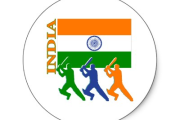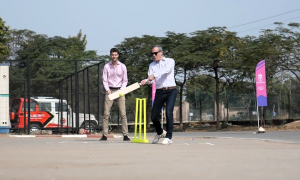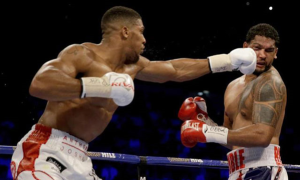Kabaddi is a 4,000 year old team sport originated in India and played by many South Asian nations. The name derives from a Tamil word meaning “holding of hand”, which is the crucial aspect of play. It is a team sport, which requires both skill and power, and combines the characteristics of wrestling and rugby. It was originally meant to develop self defense, in addition to responses to attack, and reflexes of counter attack by individuals, and by groups or teams. It is a rather simple and inexpensive game, and neither requires a massive playing area, nor any expensive equipment.
Modern Kabaddi is a synthesis of the game played in various forms under different names. It was introduced by Vivek Samvedi from Mumbai. Samit Damad then introduced some new rules which are effective since 14th July 2011. The game has been played in its original form since Vedic times. Kabaddi received international exposure during the 1936 Berlin Olympics, demonstrated by Hanuman Vyayam Prasarak Mandal, Amaravati, Maharashtra.
The game was introduced in the Indian Olympic Games at Calcutta in 1938. In 1950 the All India Kabaddi Federation came into existence and compiled standard rules. In 1955, First Kabaddi Indian National Championship was held in Calcutta. It was here that women played competitively for the first time. Although this thigh slapping, full body contact sport doesn’t seem to be very popular with the ladies, it is fancied by men worldwide, yet rarely seen on TV. The Amateur Kabaddi Federation of India (AKFI) was founded in 1973. It is the national game of Bangladesh and the state game of Tamil Nadu, Punjab and Andhra Pradesh in India. Kabaddi is the Only Game being played in all the 3 versions of Asian Games i.e. Asian Games, Asian Indoor Games and Asian Beach Games.
In the international team version of kabaddi, two teams of seven members each occupy opposite halves of a field of 10m x 13m in case of men and 8m x 11m in case of women. Each has three supplementary players held in reserve. The game is played with 20 minute halves and a five minute halftime break during which the teams exchange sides. Two teams occupy opposite halves of a field and take turns sending a “raider” into the other half, in order to win points by tackling members of the opposing team; the raider then tries to return to his own half, holding his breath and chanting “kabaddi, kabaddi, kabaddi” during the whole raid. Meanwhile, defenders must form a chain, for example, by linking hands; if the chain is broken, a member of the defending team is sent off. The goal of the defenders is to stop the raider from returning to the home side before taking a breath.
The raider is sent off the field if: 1) the raider takes a breath before returning or 2) the raider crosses boundary line or 3) A part of the raider’s body touches the ground outside the boundary (except during a struggle with an opposing team member). Each time a player is out the opposing team earns a point. A team scores a bonus of two points, called a lona, if the entire opposing team is declared out. At the end of the game, the team with the most points wins.
India is unsurmontable champions of Kabaddi World Cup, since it was first played in 2004 and then in 2007 and 2010. Iran is the next most successful nation being twice runner-up. Pakistan was the runner-up in 2010. Kabaddi World Cup 2011 is scheduled to be played in India.
Tags: India, Kabaddi, Kabaddi World Cup, Power, Raider, Skill, Sport










